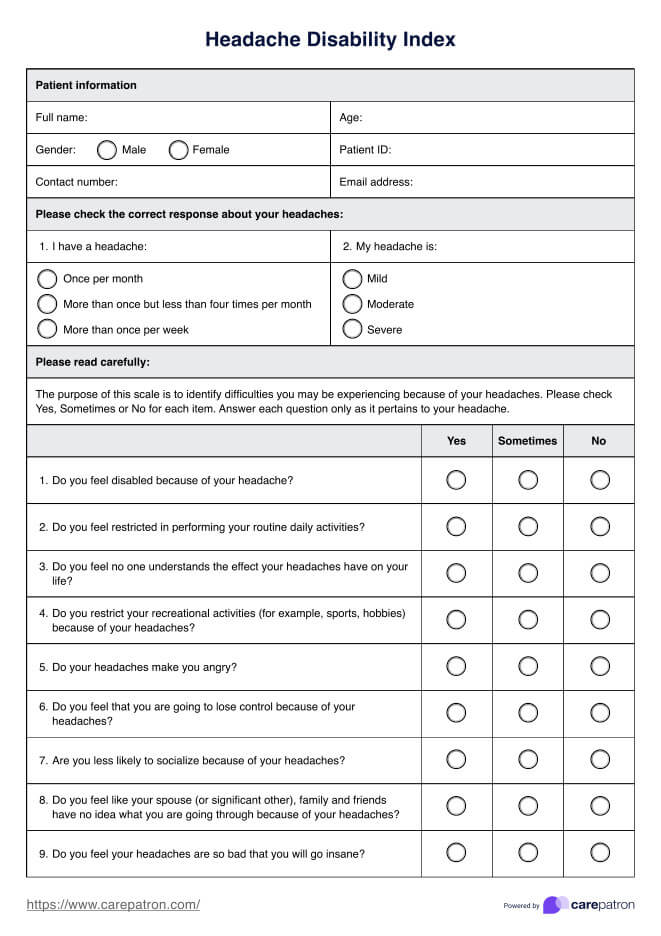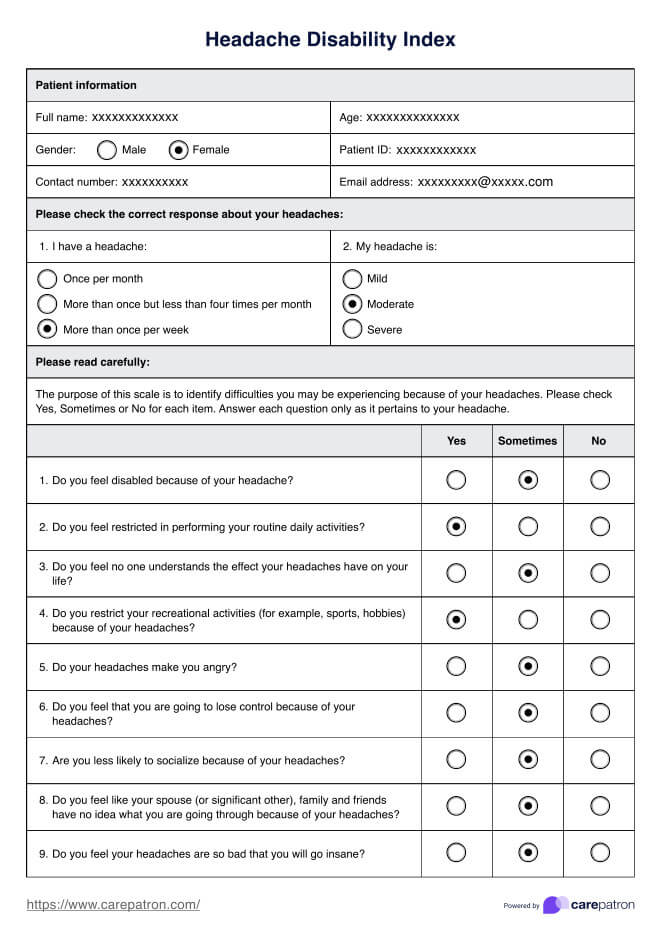Headache Disability Index
Assess the impact of your patients' headaches on their daily living with our Headache Disability Index.


What are headaches?
Headaches are a prevalent source of discomfort, impacting individuals' daily lives with varying intensity and frequency. Understanding the types of headaches is crucial for effective management and relief. Here's a quick 101 of three of the most common primary headaches or headache disorders:
- Tension headache: This is the most common type of headache, often triggered by stress and poor posture. It's a dull, aching pain that feels like a tight band around the head.
- Cluster headaches: This type of headache is characterized by severe burning and piercing pain that occurs in series, attacks frequently, and lasts 15 minutes to 3 hours.
- Migraine headaches: This type of headache features intense pulsing pain typically on one side of the head and is usually accompanied by light sensitivity and nausea.
Headache Disability Index
Headache Disability Index
What is the Headache Disability Index (HDI)?
The Headache Disability Index (HDI), also known as the Headache Disability Inventory, is a standardized tool used to evaluate the impact of headaches on an individual’s daily life. It aids healthcare professionals in understanding the extent to which headaches affect an individual’s life and thereby guides appropriate management and treatment strategies.
The HDI consists of 25 questions. Respondents must indicate whether each item applies to their headache experience by selecting “yes,” “sometimes,” or “no.” These questions address various aspects of life affected by their headaches, including social activities, relationships, and emotional well-being.
How does our Headache Disability Index (HDI) template work?
Using a Headache Disability Index template involves several steps to accurately assess and identify the impact of headaches on an individual's daily life. To effectively use the templates, follow the steps below:
Step 1: Obtain the Headache Disability Index (HDI) template
Access and download a copy of the template by clicking the "Use Template" or "Download Template" buttons in this guide. If you're on Carepatron, you can find a copy of the template by searching for "Headache Disability Index" in our template gallery.
Step 2: Ask the patient to answer the template
Have your patient review each question on the template thoroughly to understand what aspect of your life it addresses, such as social activities, relationships, or emotional well-being. For each question, ask them to choose and mark the response that best reflects their experience: "yes," "sometimes," or "no."
Step 3: Score and interpret
After your patient completes the HDI template, obtain and interpret the score. Feel free to use the "Scoring and Interpretation" section below to help you.
Headache Disability Index (HDI) scoring and interpretation
Scoring and interpreting the results of the Headache Disability Index is pretty simple and straightforward.
For scoring, after the patient completes all the questions, tally the scores based on the provided scoring system in the template. Each response category is assigned specific points. To be more specific, a "yes" answer is equivalent to 4 points, a "sometimes" answer is equivalent to 2 points, and a "no" answer is 0.
After you calculate the total score, please refer to the HDI scale below to interpret the score and determine your patient's level of disability and pain severity.
- Mild disability: 10 to 28
- Moderate disability: 30 to 48
- Severe disability: 50 to 68
- Complete disability: 72 or higher
Benefits of using our template
The Headache Disability Index serves as a valuable clinical and self-assessment tool for evaluating the impact of headaches on an individual’s daily life. Here are the benefits of using the test and template:
- Diagnosis and management: The test can be used by healthcare professionals to diagnose and manage headaches by assessing the level of disability.
- Treatment evaluation: With the test and template, the healthcare practitioner can track the progress and effectiveness of their treatments, allowing changes in interventions when needed.
- Personal evaluation: The HDI can be used as a personalized self-assessment of headache-related disability.
Managing and treating headaches
Though context must always be considered when managing and treating headaches, some common treatments and strategies for headaches are:
- Rest and relaxation: Patients will be asked to take a break from external stimuli and find a quiet, dark room if it helps to alleviate headache symptoms.
- Over-the-counter medications: Recommended dosages of over-the-counter medication like ibuprofen, acetaminophen, or aspirin can help alleviate headache pain.
- Hot or cold compresses: A hot or cold compress to one's head or neck may also provide relief.
- Caffeine: For certain cases, a small amount of caffeine may help ease headache discomfort.
Commonly asked questions
Some examples are infection, hypertension, head injuries, acute sinusitis, and meningitis.
The most commonly used functional outcome measures for headaches are the Migraine Disability Assessment (MIDAS) questionnaire and the Headache Impact Test (HIT-6). The MIDAS assesses the impact of migraine on an individual’s ability to perform daily activities, while the HIT-6 evaluates the overall impact of headaches on a person’s ability to function. These tools provide a standardized way to quantify the functional disability caused by different types of headaches, including migraine, tension-type, and cluster headaches.
The Headache Disability Index (HDI) was originally developed at the Henry Ford Hospital by Jacobson and colleagues in 1994. It is a questionnaire designed to quantify the impact of headaches on daily living. It includes functional and emotional subscales to assess the impact of headache and its treatment.







































































































